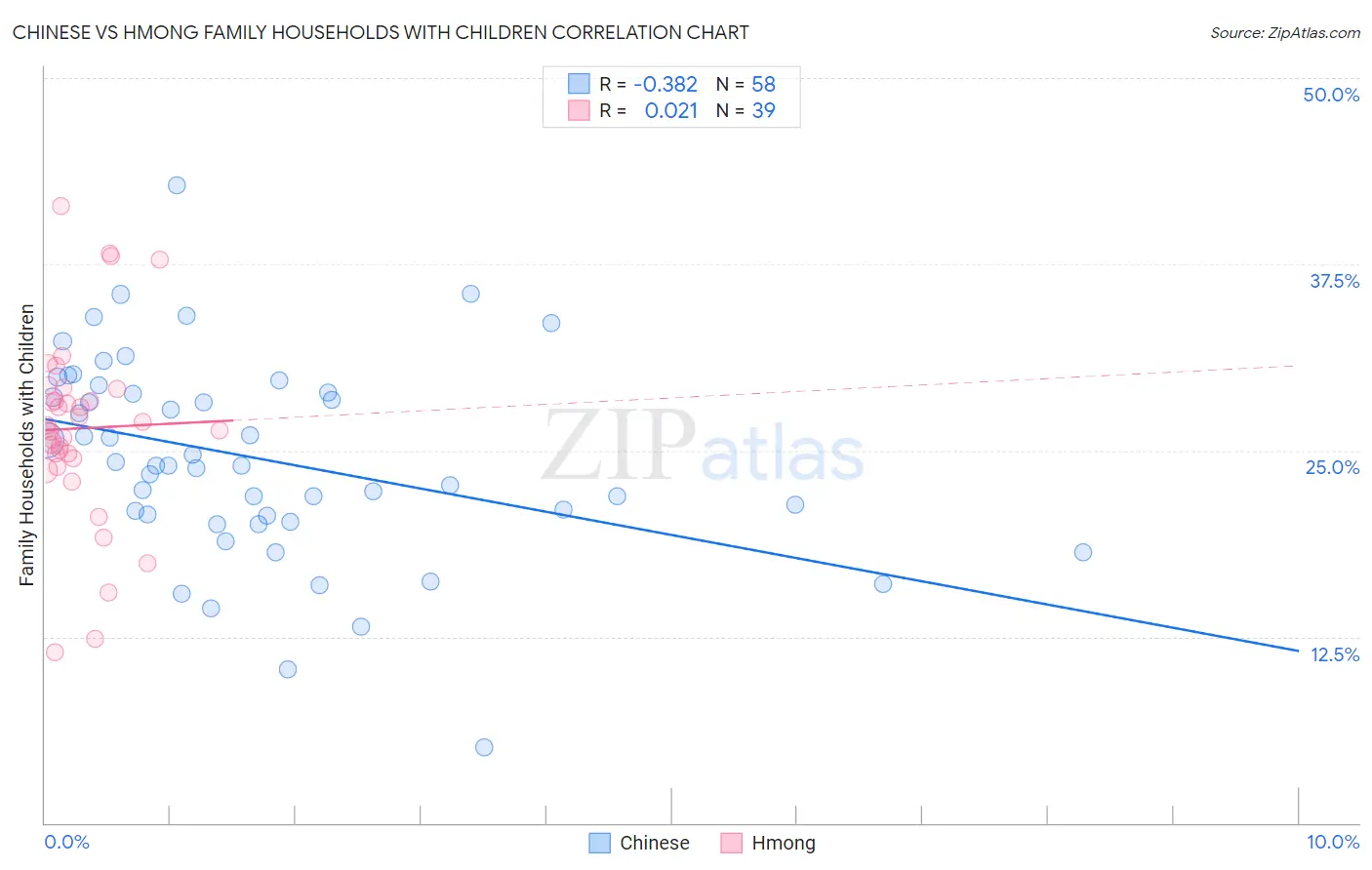Chinese vs Hmong Family Households with Children
COMPARE
Chinese
Hmong
Family Households with Children
Family Households with Children Comparison
Chinese
Hmong
26.0%
FAMILY HOUSEHOLDS WITH CHILDREN
0.0/ 100
METRIC RATING
324th/ 347
METRIC RANK
28.6%
FAMILY HOUSEHOLDS WITH CHILDREN
99.9/ 100
METRIC RATING
60th/ 347
METRIC RANK
Chinese vs Hmong Family Households with Children Correlation Chart
The statistical analysis conducted on geographies consisting of 64,800,060 people shows a mild negative correlation between the proportion of Chinese and percentage of family households with children in the United States with a correlation coefficient (R) of -0.382 and weighted average of 26.0%. Similarly, the statistical analysis conducted on geographies consisting of 24,678,157 people shows no correlation between the proportion of Hmong and percentage of family households with children in the United States with a correlation coefficient (R) of 0.021 and weighted average of 28.6%, a difference of 10.0%.

Family Households with Children Correlation Summary
| Measurement | Chinese | Hmong |
| Minimum | 5.1% | 11.4% |
| Maximum | 42.8% | 41.4% |
| Range | 37.7% | 30.0% |
| Mean | 24.4% | 26.5% |
| Median | 24.0% | 26.4% |
| Interquartile 25% (IQ1) | 20.6% | 24.5% |
| Interquartile 75% (IQ3) | 28.8% | 29.2% |
| Interquartile Range (IQR) | 8.2% | 4.7% |
| Standard Deviation (Sample) | 6.8% | 6.3% |
| Standard Deviation (Population) | 6.7% | 6.2% |
Similar Demographics by Family Households with Children
Demographics Similar to Chinese by Family Households with Children
In terms of family households with children, the demographic groups most similar to Chinese are Immigrants from Australia (26.0%, a difference of 0.030%), Barbadian (26.0%, a difference of 0.060%), Immigrants from Greece (26.0%, a difference of 0.070%), British West Indian (26.0%, a difference of 0.080%), and Immigrants from Ireland (26.0%, a difference of 0.080%).
| Demographics | Rating | Rank | Family Households with Children |
| Ottawa | 0.0 /100 | #317 | Tragic 26.1% |
| Iroquois | 0.0 /100 | #318 | Tragic 26.1% |
| Immigrants | France | 0.0 /100 | #319 | Tragic 26.0% |
| Tlingit-Haida | 0.0 /100 | #320 | Tragic 26.0% |
| British West Indians | 0.0 /100 | #321 | Tragic 26.0% |
| Immigrants | Greece | 0.0 /100 | #322 | Tragic 26.0% |
| Immigrants | Australia | 0.0 /100 | #323 | Tragic 26.0% |
| Chinese | 0.0 /100 | #324 | Tragic 26.0% |
| Barbadians | 0.0 /100 | #325 | Tragic 26.0% |
| Immigrants | Ireland | 0.0 /100 | #326 | Tragic 26.0% |
| Immigrants | Barbados | 0.0 /100 | #327 | Tragic 26.0% |
| Immigrants | Albania | 0.0 /100 | #328 | Tragic 25.9% |
| Cypriots | 0.0 /100 | #329 | Tragic 25.9% |
| Immigrants | Latvia | 0.0 /100 | #330 | Tragic 25.9% |
| Slovenes | 0.0 /100 | #331 | Tragic 25.8% |
Demographics Similar to Hmong by Family Households with Children
In terms of family households with children, the demographic groups most similar to Hmong are Immigrants from Nigeria (28.6%, a difference of 0.060%), Immigrants from Ghana (28.6%, a difference of 0.070%), Egyptian (28.6%, a difference of 0.080%), Immigrants from Lebanon (28.6%, a difference of 0.090%), and Filipino (28.6%, a difference of 0.16%).
| Demographics | Rating | Rank | Family Households with Children |
| Immigrants | Cambodia | 100.0 /100 | #53 | Exceptional 28.9% |
| Sierra Leoneans | 100.0 /100 | #54 | Exceptional 28.9% |
| Immigrants | Asia | 100.0 /100 | #55 | Exceptional 28.8% |
| Immigrants | Guatemala | 100.0 /100 | #56 | Exceptional 28.8% |
| Danes | 100.0 /100 | #57 | Exceptional 28.7% |
| Hawaiians | 100.0 /100 | #58 | Exceptional 28.7% |
| Immigrants | Nigeria | 100.0 /100 | #59 | Exceptional 28.6% |
| Hmong | 99.9 /100 | #60 | Exceptional 28.6% |
| Immigrants | Ghana | 99.9 /100 | #61 | Exceptional 28.6% |
| Egyptians | 99.9 /100 | #62 | Exceptional 28.6% |
| Immigrants | Lebanon | 99.9 /100 | #63 | Exceptional 28.6% |
| Filipinos | 99.9 /100 | #64 | Exceptional 28.6% |
| Hondurans | 99.9 /100 | #65 | Exceptional 28.5% |
| Immigrants | Egypt | 99.9 /100 | #66 | Exceptional 28.5% |
| Ghanaians | 99.9 /100 | #67 | Exceptional 28.5% |